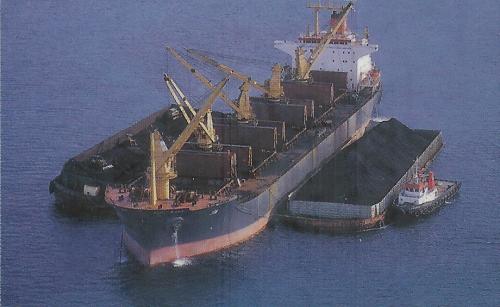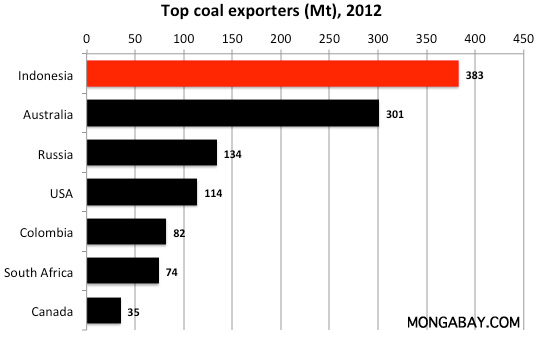March 1, 2015 – In 2012 Indonesia’s contribution to greenhouse gas (GHG) global emissions amounted to 4.5%. That placed them sixth, well behind the United States, China and Germany. The world’s fourth largest country in population produces these emissions largely through the destruction of its rainforests and the burning of peat fires. These emission are largely agrarian in nature. Which brings us to the question, what happens when Indonesia industrializes?
The government recognizes it has a problem. Today other than agricultural production and forest products, Indonesia is all about coal. It currently is the leading producer on the globe (see graph below). Much of it goes to fulfil China’s enormous thirst for energy. And now the nation is witnessing its own industrialization and energy demands meaning less for export. That means increased GHG emissions at a time when the country’s political leaders are pledging to reduce net carbon emissions by 26% by 2020.
Although sixth in the world in emissions Indonesia today produces a mere 2 tons of CO2 per year for each of its citizens. Why a mere? Because when compared to the 16 tons contribution for every American, Indonesia’s carbon pollution contribution appears small.
In addition 50% of Indonesian families live below the poverty line. So what happens when the country wants to raise the living standards of that 50%? It would seem the easiest way would be to make more energy available to them so that they can move to urban centres and take on better jobs. And abundant coal appears to be the fuel of choice to light those cities.
But like so many Developing Countries on the planet, Indonesia is caught between two very different moral crises. Political leaders have made pledges to international bodies to reduce GHG emissions, a noble gesture but utterly unachievable in light of the need to improve the quality of life for its citizens.
Indonesia wants to use its coal responsibly and hopes that carbon capture and sequestration (CCS) will be the solution. The goal, to capture 90% of CO2 emissions produced from fossil fuels used to generate electricity and in industrial processes. The CO2 would then be transported by pipeline to ships for safe storage. Those ships would then be sent to aging offshore oil fields where the CO2 would be pumped into the ground to enhance oil recovery. The Energy and Minerals Resource Ministry has recommended a carbon tax of $100 US per ton to finance CCS development.
If you are regular reader of this blog then you know that CCS continues to struggle as a carbon reduction strategy. Just a few weeks ago the U.S. government pulled the plug on a pilot CCS project. And the U.S. is not alone. France, Germany, Sweden and Spain just opted out of a CCS project of their own. All these countries cited the cost of CCS as being prohibitive. But maybe a $100 levy per ton of carbon on energy producers and industry may prove the right carrot and stick strategy to get CCS on track and maybe Indonesia will take a leading role in making it an option for implementing a low carbon future.










